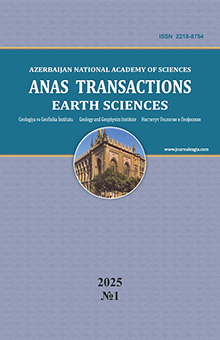№ 1,
2014
Download the article
Genetic-formational classification of orebearing metasomatic complexes of the Lesser Caucasus
Institute of Geology and Geophysics of Azerbaijan National Academy of Sciences, AZ1143, Baku, H.Javid av., 119
E-mail: jazadaliyev@rambler.ru
Summary
A-
A+
Different orebearing metasomatic complexes are widely spread in the Lesser Caucasus due to hydrothermal activity of the MesoCenozoic magmatism, their genetic-formational classification is of scientific-practical importance. The base for similar classification is presented by the results of author’s basic investigations in field of metasomatism and oreformation on study of different aspect of main formational types of orebearing metasomatic complexes developed in structural-formational zones of the region. In spite of spatial extension of the region, complexity of study areas and genetic diversity of orebearing metasomatic complexes, the systematization of the last ones became possible. There are two approaches or two principles in classification of orebearing metasomatites, they are genetical and formational. Genetic classification allows to conduct analysis of the physical-chemical formation conditions of typomorphic mineral associations of metasomatites and ore accumulations connected with them. Along with a number of significant aspects the formational classification shows connection between historical-geological development of orebearing metasomatites and tectonic-magmatic and lithological processes. So, it is efficient to create classification of orebearing metasomatic complexes using two principles – first genetical and then formational. Orebearing metasomatic formation is an integral element of metasomatic complexes classification. Orebearing metasomatic formation is represented by metasomatites and ores connected with them which consist of paragenetic associations of typomorphic minerals, their formations are interrelated on space and time repeating in Earth Crust in definite period of time.
The main basic elements of genetical-formational classification are the following: 1) Material-mineral composition of orebearing metasomatites, their geological and physical-chemical conditions of formations; 2) Genetic connection with definite magmatism indicating age; 3) Composition and age of initial rocks; 4) Mineral parageneses and mineral facies of metasomatites; 5) Composition and texture-structural peculiarities of ores; 6) Metasomatic zonation; 7) PT conditions, etc.
To improve classification a number of significant questions was defined: 1) Geological and physical-chemical formation conditions of the main formational types of orebearing metasomatic complexes were determined; 2) Zonation and material-mineral composition (typomorphic minerals and their parageneses) of the same named but different age orebearing metasomatic formations were studied indicating the same and different features; 3) Peculiarities of compositions and structure of orebearing metasomatic formations were determined, and also their facial zonation and oreformation in it during hydrothermal metasomatic processes, relationship between ore mineralization and wallrock metasomatic changes; specific features of wallrock changes were revealed. As a result of author’s many years research the following was defined: any ore mineralization can’t be found out of fields of metasomatic changes. Although availability of metasomatic changes increases possibility to reveal ore accumulations however, it doesn’t provide a guarantee at all.
Metasomatic formations (quartz-fieldspar metasomatites, skarn metasomatites, greizens, propylites, secondary quartz, solfataric and hydrothermal argillizites, listvenites, serpentinites, etc) are searching criteria of regional nature, but wallrock metasomatic changes (preore, syn-ore and post-ore) are very valuable as reliable criteria in direct search and prediction of hidden ore accumulations.
